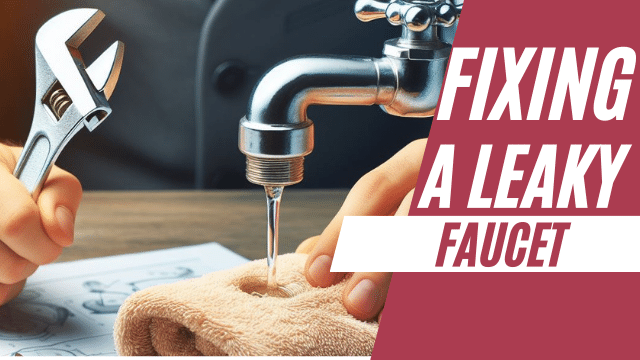A leaky faucet is not only an audible nuisance but also a source of potential water wastage. In this guide, we will explore the process of how to fix a leaky faucet through a DIY approach, understanding the common issues, and discussing when it might be time to consider professional help.
Common Faucet Leaks: Identifying the Culprit
Understanding the source of the leak is the first step in effective leaky faucet repair. Among the most common faucet leaks are those caused by worn-out washers, O-rings, or damaged seals. These components, subjected to constant water pressure, can deteriorate over time, leading to persistent leaks and that familiar faucet dripping sound.
DIY Leaky Faucet Repair: Quick and Efficient
For those inclined towards a hands-on solution, a DIY leaky faucet repair is often achievable. Begin by turning off the water supply to the affected faucet. This preliminary step is crucial to avoid unexpected water spillage during the repair process.
Tools of the Trade: Essential Equipment for Faucet Repair
To execute a successful leaky faucet repair, having the best tools for faucet repair is essential. Your toolkit should include an adjustable wrench, pliers, a screwdriver, and a pipe wrench. Each of these tools serves a specific purpose, from dismantling the faucet to replacing worn-out components.
Eco-Friendly Faucet Repair: A Responsible Approach
Embracing an eco-friendly faucet repair not only addresses the immediate issue but aligns with environmental consciousness. Recognize that even a minor leak can contribute to significant water wastage from leaks over time. Prompt attention to leaks is a small but impactful step toward water conservation.
Preventing Future Faucet Leaks: Proactive Measures
Knowing how to prevent faucet leaks is as crucial as fixing existing ones. Regular maintenance, lubrication of moving parts, and vigilant observation for signs of wear can extend the life of your faucet. A proactive approach to even minor leaks can prevent them from evolving into major issues.
DIY vs. Professional Help: Weighing Your Options
While a DIY leaky faucet repair is commendable, situations may arise where professional help is warranted. If you’re uncertain about identifying faucet leaks or if the leak persists despite your efforts, consider hiring a plumber for leaks. Their expertise ensures a thorough diagnosis and effective resolution of the issue.
Faucet Repair vs. Replacement: Making Informed Decisions
The debate of faucet repair vs. replacement often hinges on the extent of damage and the overall condition of the faucet. Assess these factors to determine the most cost-effective and sustainable solution for your situation.
Stopping a Leaky Tap: Practical Tips
Effectively stopping a leaky tap involves more than just fixing the visible signs. Utilize faucet leak detection tips to identify hidden leaks. Sealing leaky faucet joints with appropriate sealants ensures a comprehensive repair. These small yet crucial steps can make a significant difference in preventing future leaks.
Finding a Local Plumber: Professional Assistance
For those who prefer professional assistance, finding a local plumber for leaks is a key step. Their specialized knowledge ensures a thorough diagnosis and resolution of your faucet issues, providing peace of mind and a reliable solution.
In conclusion, mastering how to fix a leaky faucet involves a combination of DIY efforts, eco-friendly practices, and professional assistance when needed. By understanding the nuances of faucet repair, you not only contribute to water and money savings but also foster a sustainable and responsible living environment.
Mastering the Art of Fixing a Leaky Faucet: A Comprehensive Guide
A leaky faucet isn’t just an irritating sound; it’s a persistent problem that can lead to water wastage and potential damage. In this detailed guide, we’ll delve into the intricate process of fixing a leaky faucet, emphasizing DIY techniques, technical know-how, and proactive measures to ensure a long-lasting solution.
Diagnosing the Culprit: Identifying Common Faucet Leaks
Before embarking on the repair journey, it’s crucial to identify the source of the leak. Common issues often stem from worn-out washers, O-rings, or damaged seals, culminating in that familiar faucet dripping sound. A keen eye for these signs is the first step in effective leaky faucet troubleshooting.
DIY Faucet Repair: Tools and Techniques
Essential Tools for the Job
Equipping yourself with the best tools for faucet repair is fundamental. A well-rounded toolkit should include an adjustable wrench, pliers, a screwdriver, and a pipe wrench. These tools, used in harmony, facilitate the dismantling and reassembly process required for a successful DIY leaky faucet repair.
Step-by-Step Repair Techniques
- Turn Off the Water Supply: Begin by turning off the water supply to the affected faucet. This prevents unexpected water spillage during the repair.
- Dismantle the Faucet: Use the adjustable wrench and screwdriver to carefully dismantle the faucet, exposing the internal components.
- Inspect and Replace Worn Parts: Identify the worn-out washers, O-rings, or seals causing the leak. Replace them with new, compatible parts, ensuring a snug fit.
- Reassemble the Faucet: With the new components in place, meticulously reassemble the faucet, ensuring all parts are tightly secured.
- Turn On the Water: Gradually turn on the water supply and check for leaks. Make necessary adjustments if any issues persist.
Eco-Friendly Faucet Repair: A Responsible Approach
Beyond fixing the immediate issue, adopting an eco-friendly faucet repair approach aligns with environmental consciousness. Even seemingly minor leaks contribute to significant water wastage over time. By promptly addressing leaks, you actively participate in water conservation efforts.
Preventing Future Faucet Leaks: Proactive Maintenance
Prevention is often more effective than cure. Knowing how to prevent faucet leaks involves regular maintenance practices. Lubricate moving parts, inspect for signs of wear, and address any issues promptly. This proactive approach significantly extends the lifespan of your faucet.
Professional Assistance: Hiring a Plumber for Complex Leaks
While DIY efforts are commendable, situations may arise where professional assistance is necessary. If identifying faucet leaks proves challenging or if the leak persists, hiring a plumber for leaks ensures a thorough diagnosis. Their expertise guarantees a comprehensive and long-lasting solution.
Faucet Repair vs. Replacement: Making Informed Decisions
The decision between faucet repair vs. replacement hinges on factors like the extent of damage and overall condition. A thorough assessment helps determine the most cost-effective and sustainable solution for your unique situation.
Advanced Techniques: Sealing Leaky Faucet Joints
Addressing leaks goes beyond fixing visible signs. Utilize advanced techniques like sealing leaky faucet joints with appropriate sealants. These meticulous steps ensure a comprehensive repair, preventing future leaks and maintaining optimal faucet performance.
Finding a Local Plumber: Your Expert Partner
For those who prefer professional assistance, finding a local plumber for leaks is a key step. Their specialized knowledge and advanced tools guarantee a thorough diagnosis and resolution, providing peace of mind and a reliable, long-term solution.
In conclusion, mastering the art of fixing a leaky faucet involves a combination of DIY prowess, technical know-how, and the wisdom to seek professional assistance when needed. By understanding the nuances of faucet repair, you contribute not only to water and money savings but also to a sustainable and responsible living environment.


